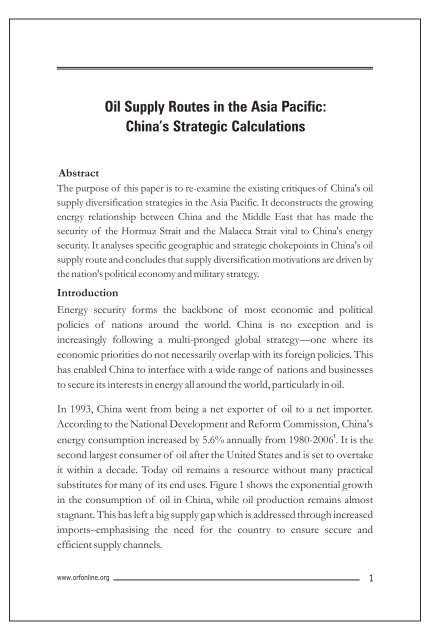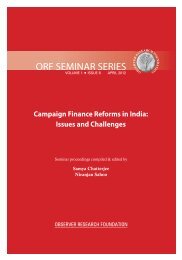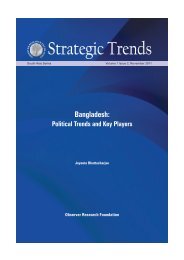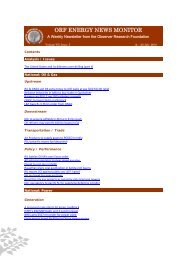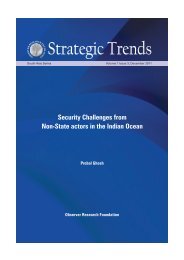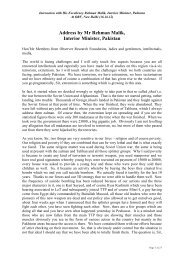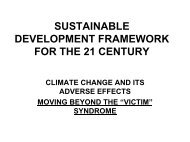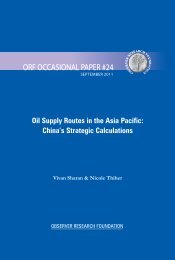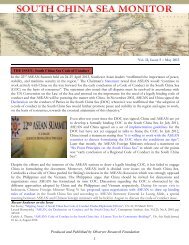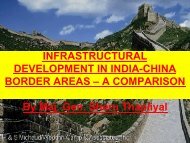Oil Supply Routes in the Asia Pacific: China's Strategic Calculations
Oil Supply Routes in the Asia Pacific: China's Strategic Calculations
Oil Supply Routes in the Asia Pacific: China's Strategic Calculations
Create successful ePaper yourself
Turn your PDF publications into a flip-book with our unique Google optimized e-Paper software.
<strong>Oil</strong> <strong>Supply</strong> <strong>Routes</strong> <strong>in</strong> <strong>the</strong> <strong>Asia</strong> <strong>Pacific</strong>:<br />
Ch<strong>in</strong>a’s <strong>Strategic</strong> <strong>Calculations</strong><br />
Abstract<br />
The purpose of this paper is to re-exam<strong>in</strong>e <strong>the</strong> exist<strong>in</strong>g critiques of Ch<strong>in</strong>a's oil<br />
supply diversification strategies <strong>in</strong> <strong>the</strong> <strong>Asia</strong> <strong>Pacific</strong>. It deconstructs <strong>the</strong> grow<strong>in</strong>g<br />
energy relationship between Ch<strong>in</strong>a and <strong>the</strong> Middle East that has made <strong>the</strong><br />
security of <strong>the</strong> Hormuz Strait and <strong>the</strong> Malacca Strait vital to Ch<strong>in</strong>a's energy<br />
security. It analyses specific geographic and strategic chokepo<strong>in</strong>ts <strong>in</strong> Ch<strong>in</strong>a's oil<br />
supply route and concludes that supply diversification motivations are driven by<br />
<strong>the</strong> nation's political economy and military strategy.<br />
Introduction<br />
Energy security forms <strong>the</strong> backbone of most economic and political<br />
policies of nations around <strong>the</strong> world. Ch<strong>in</strong>a is no exception and is<br />
<strong>in</strong>creas<strong>in</strong>gly follow<strong>in</strong>g a multi-pronged global strategy—one where its<br />
economic priorities do not necessarily overlap with its foreign policies. This<br />
has enabled Ch<strong>in</strong>a to <strong>in</strong>terface with a wide range of nations and bus<strong>in</strong>esses<br />
to secure its <strong>in</strong>terests <strong>in</strong> energy all around <strong>the</strong> world, particularly <strong>in</strong> oil.<br />
In 1993, Ch<strong>in</strong>a went from be<strong>in</strong>g a net exporter of oil to a net importer.<br />
Accord<strong>in</strong>g to <strong>the</strong> National Development and Reform Commission, Ch<strong>in</strong>a's<br />
1<br />
energy consumption <strong>in</strong>creased by 5.6% annually from 1980-2006 . It is <strong>the</strong><br />
second largest consumer of oil after <strong>the</strong> United States and is set to overtake<br />
it with<strong>in</strong> a decade. Today oil rema<strong>in</strong>s a resource without many practical<br />
substitutes for many of its end uses. Figure 1 shows <strong>the</strong> exponential growth<br />
<strong>in</strong> <strong>the</strong> consumption of oil <strong>in</strong> Ch<strong>in</strong>a, while oil production rema<strong>in</strong>s almost<br />
stagnant. This has left a big supply gap which is addressed through <strong>in</strong>creased<br />
imports–emphasis<strong>in</strong>g <strong>the</strong> need for <strong>the</strong> country to ensure secure and<br />
efficient supply channels.<br />
www.orfonl<strong>in</strong>e.org 1


